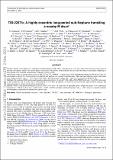TOI-2257 b: A highly eccentric long-period sub-Neptune transiting a nearby M dwarf
Author(s)
De Wit, Julian; Seager, Sara; Ricker, George
DownloadAccepted version (2.334Mb)
Open Access Policy
Open Access Policy
Creative Commons Attribution-Noncommercial-Share Alike
Terms of use
Metadata
Show full item recordAbstract
<jats:p><jats:italic>Context.</jats:italic> Thanks to the relative ease of finding and characterizing small planets around M-dwarf stars, these objects have become cornerstones in the field of exoplanet studies. The current paucity of planets in long-period orbits around M dwarfs makes such objects particularly compelling as they provide clues about the formation and evolution of these systems.</jats:p>
<jats:p><jats:italic>Aims.</jats:italic> In this study we present the discovery of TOI-2257 b (TIC 198485881), a long-period (35 d) sub-Neptune orbiting an M3 star at 57.8 pc. Its transit depth is about 0.4%, large enough to be detected with medium-size, ground-based telescopes. The long transit duration suggests the planet is in a highly eccentric orbit (<jats:italic>e</jats:italic> ~ 0.5), which would make it the most eccentric planet known to be transiting an M-dwarf star.</jats:p>
<jats:p><jats:italic>Methods.</jats:italic> We combined TESS and ground-based data obtained with the 1.0-meter SAINT-EX, 0.60-meter TRAPPIST-North, and 1.2-meter FLWO telescopes to find a planetary size of 2.2 <jats:italic>R</jats:italic><jats:sub>⊕</jats:sub> and an orbital period of 35.19 days. In addition, we make use of archival data, high-resolution imaging, and vetting packages to support our planetary interpretation.</jats:p>
<jats:p><jats:italic>Results.</jats:italic> With its long period and high eccentricity, TOI-2257 b falls into a novel slice of parameter space. Despite the planet’s low equilibrium temperature (~256 K), its host star’s small size (<jats:italic>R</jats:italic><jats:sub>*</jats:sub> = 0.311 ± 0.015) and relative infrared brightness (<jats:italic>K</jats:italic><jats:sub>mag</jats:sub> = 10.7) make it a suitable candidate for atmospheric exploration via transmission spectroscopy.</jats:p>
Date issued
2022Department
Massachusetts Institute of Technology. Department of Earth, Atmospheric, and Planetary SciencesJournal
Astronomy and Astrophysics
Publisher
EDP Sciences
Citation
De Wit, Julian, Seager, Sara and Ricker, George. 2022. "TOI-2257 b: A highly eccentric long-period sub-Neptune transiting a nearby M dwarf." Astronomy and Astrophysics, 657.
Version: Author's final manuscript